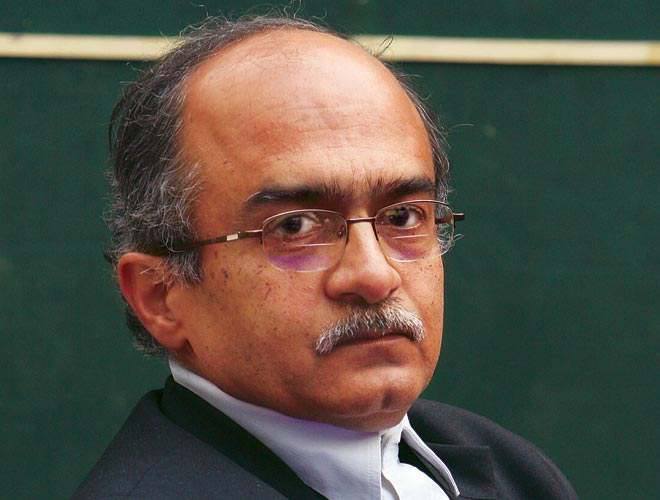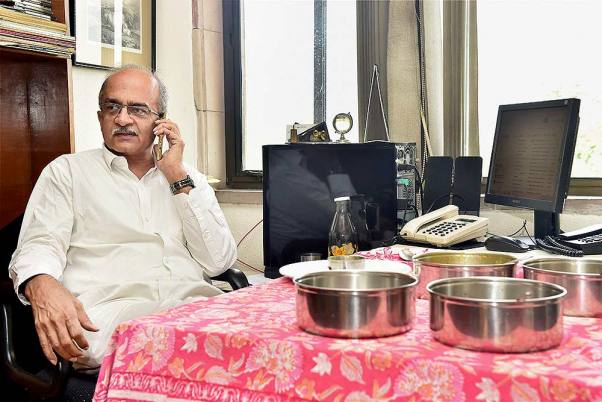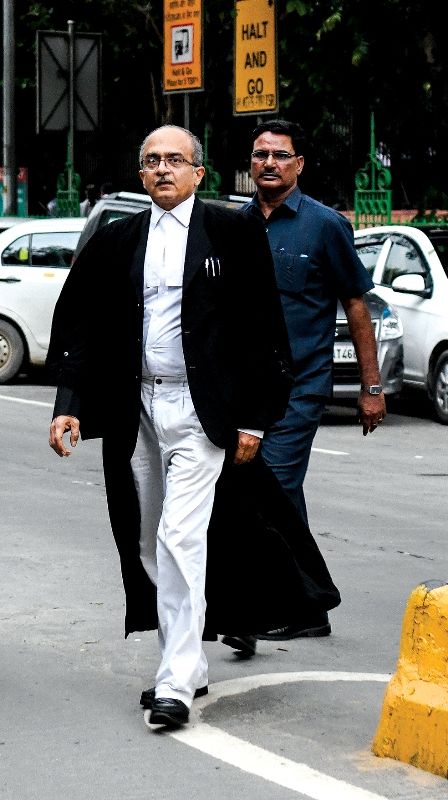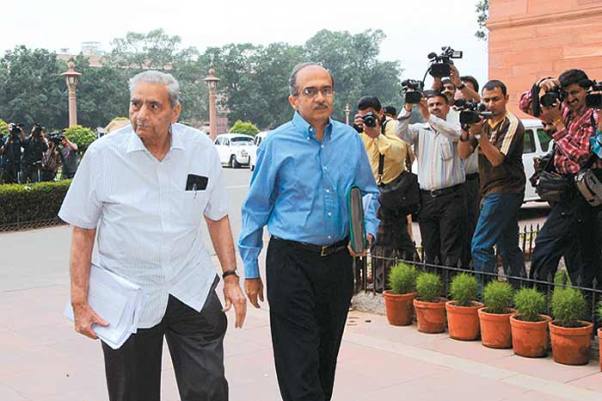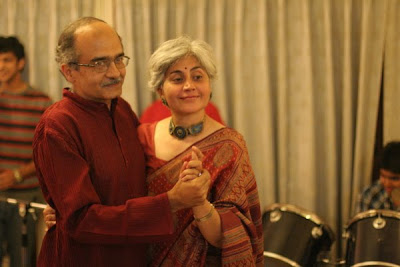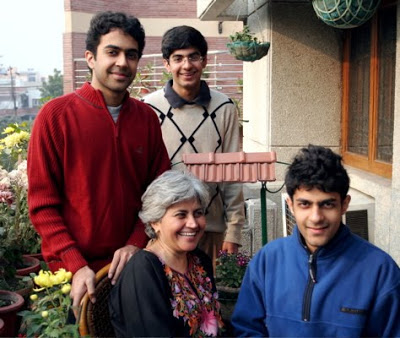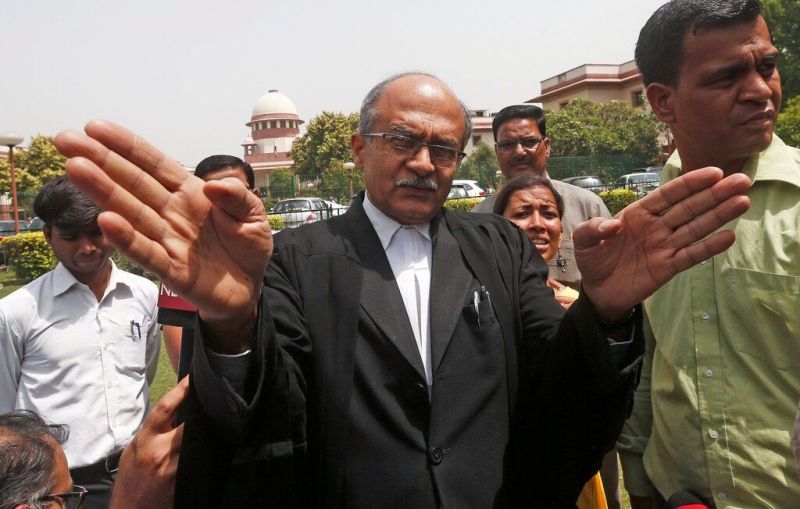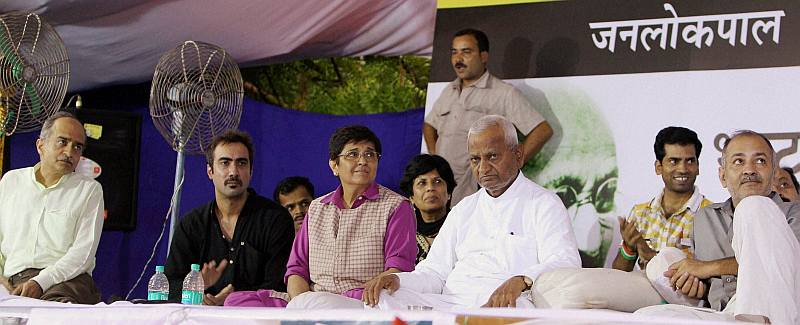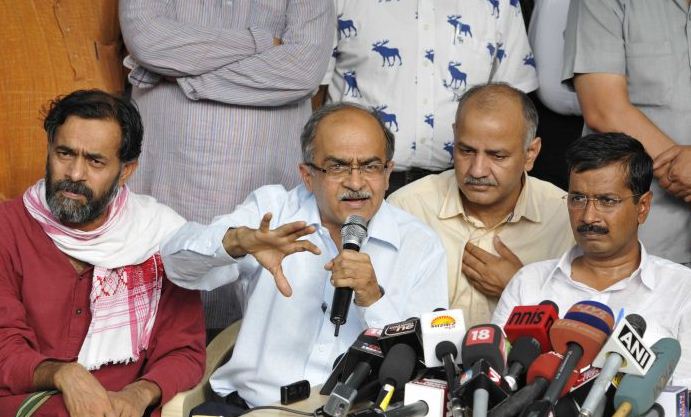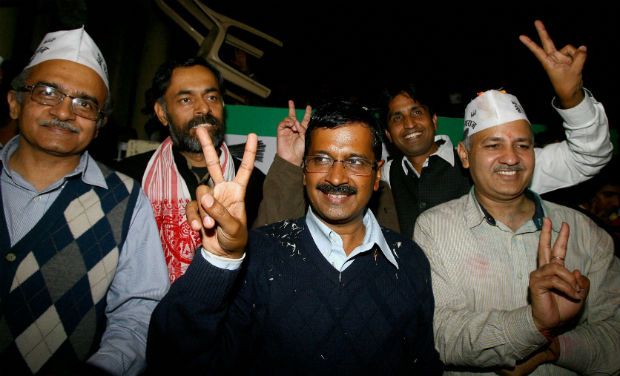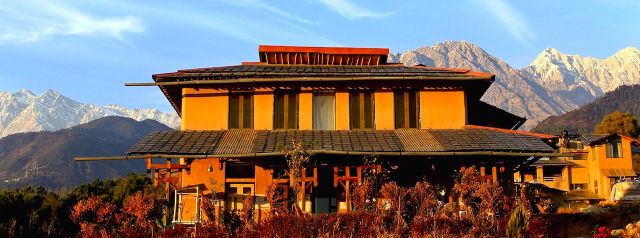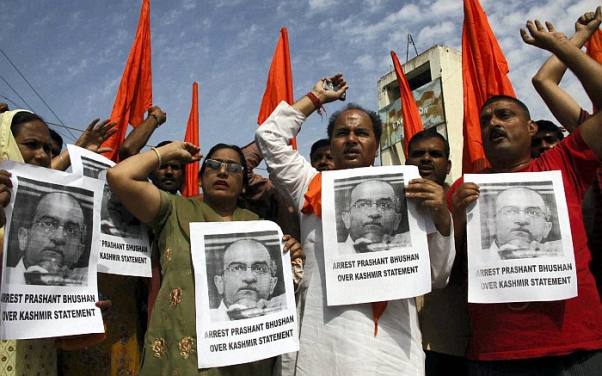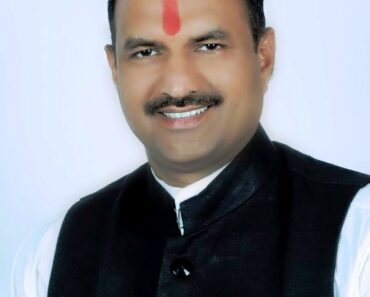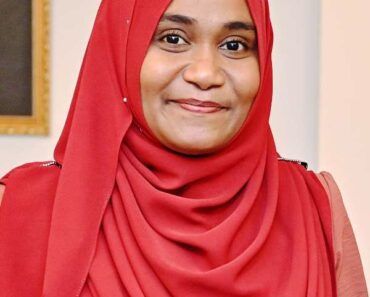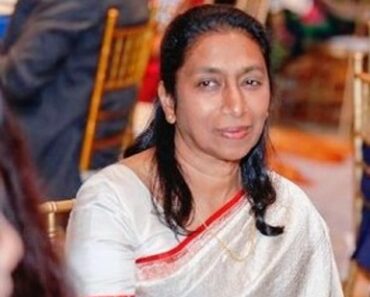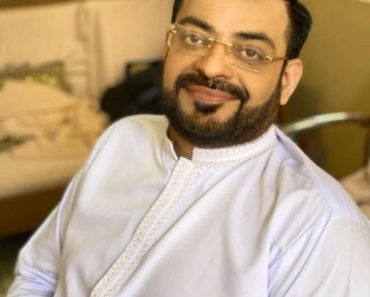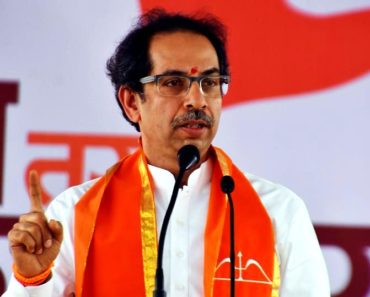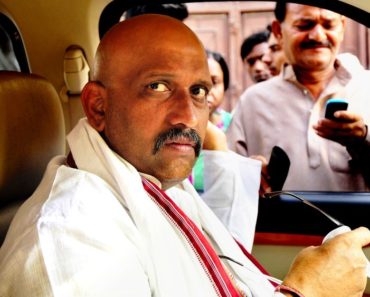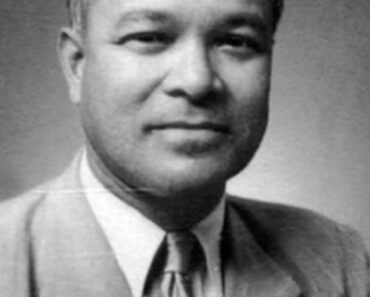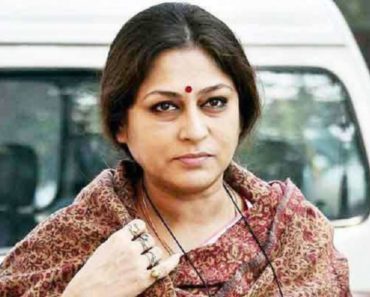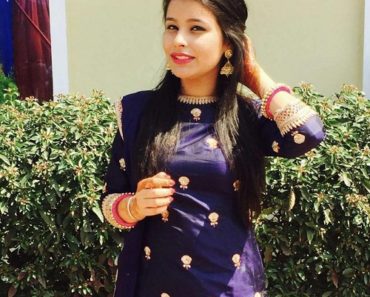Prashant Bhushan is an Indian lawyer, legal activist, and politician. The renowned senior advocate of the Supreme Court is best known for the use of public interest litigation (PIL) to fight against a variety of matters related to corruption, human rights, and environmental protection. He was a prominent member of the clan, ‘Team Anna,’ that led India Against Corruption (IOC) movement in 2011 and 2012 aimed at implementing the Jan Lokpal Bill. After the division among the key members of the IAC core committee, he played a major role in the birth of the Aam Aadmi Party (AAP) in 2012. In 2015, he made a series of accusations against the AAP and was subsequently expelled from the party for anti-party activities. He is a co-founder of Swaraj Abhiyan, a socio-political organisation, and has also laid the foundation of Sambhaavnaa, an Institute working towards educating youth on Public Policies and Politics.
Contents
Wiki/Biography
Prashant Bhushan was born on Monday, 15 October 1956 (age 66 years; as of 2022) in Allahabad (now Prayagraj), Uttar Pradesh. He went to study engineering at IIT-Madras in 1973; however, after the first semester, he dropped out of the course due to lack of interest in engineering and returned home. After returning to Allahabad, he completed his graduation with a bachelor’s degree in Political Science, Philosophy, and Economics from St. Joseph’s College in Allahabad. Thereafter, he enrolled himself at the University of Allahabad where he started pursuing LLB. Meanwhile, before completing his law degree, he got admission with a scholarship at Princeton University in the USA to do a degree in Philosophy and Economics. However, after spending one and a half years at Princeton, he realised that philosophy was a game of words and he will fetch nothing satisfactory out of it; so he came back to India. After returning, he gave his final year law exams and started his career as a lawyer in 1983.
Physical Appearance
Height (approx.): 5′ 9″
Hair Colour: White
Eye Colour: Black
Residential Address
B-16, Sector – 14, Noida, Pincode – 201301
Family & Caste
Parents & Siblings
Prashant is the first child of Shanti Bhushan (father) and Kumud Bhushan (mother). His father, Shanti Bhushan, is a veteran advocate of the Supreme Court of India, who had also served as a Minister of Law and Justice of India (from 1977 to 1979) at the time in Morarji Desai government. Shanti Bhushan was the lawyer who took on the might of Indira Gandhi by representing Raj Narain in “the State of Uttar Pradesh vs Raj Narain case” heard by the Allahabad High Court in 1975. In the judgement of the case, Indira Gandhi was found guilty of electoral malpractices in 1971 elections. This verdict led Indira Gandhi to declare an emergency.
Prashant Bhushan with his father, Shanti Bhushan, outside the Supreme Court of India. He has three younger siblings; Jayant Bhushan (brother), Shefali Bhushan (sister), and Shalini Gupta (sister).
Relationships & Children
He is married to Deepa Bhushan, a former lawyer.
The couple has three sons. The oldest son, Manav, is a Chief Technology Officer and a Co-Founder of Fourth Frontier.
A career in Judicial Activism
Prashant Bhushan embarked on his legal career in 1983 and started practising in the Supreme court of India.
Inspired by his father, Prashant Bhushan got attracted towards public activism early in his career. He took up cases of public interest related to civil liberty, human rights, corruption in higher places, socio-economic rights of the poor, or environmental cause. His first case, ‘Doon Valley Mining case,’ was for an environmental cause, challenging the limestone mining in the Doon valley in Uttarakhand. So far in his career, the anti-corruption crusader, Prashant Bhushan, has filed a significant amount of PIL’s to unfold scandals and has taken up hundreds of cases backing good causes. Here are some significant cases handled by Prashant Bhushan:
- The Narmada Dam Case
- The Bofors case (involving corruption in a major arms purchase deal)
- The Contempt of Court case against Arundhati Roy (involving Freedom of speech and criticism of the judiciary)
- The Enron case (challenging the Enron power project at Dabhol, Maharashtra, India)
- The Doon valley mining case (challenging the limestone mining in the Doon valley in India)
- The Right to Information Case (seeking government guidelines which will facilitate the right to information for citizens)
- The Panna Mukta oilfields case (challenging the sale of developed oilfields from a government company to Private companies for a pittance)
- The Oil companies’ disinvestment case (challenging the disinvestment and sale of government oil companies to the private sector)
- The Mauritius Double taxation case (challenging the tax exemption given to post box companies registered in Mauritius)
- The case by which political candidates in elections have had to disclose their assets and criminal antecedents.
- The 2G spectrum scam case
- The Chief Vigilance Commissioner appointment case
- The Radia Tapes case
- The National Rural Employment Guarantee Scheme Implementation
- The case against rampant illegal mining in Bellary and other districts of Karnataka and Andhra Pradesh
- The NTRO scam case
- The SEBI scam case
- RTI case against the judiciary seeking details about assets, appointment and inquiry, information of SC and HC judges
- The case against GM food
- The police Reforms case
- The rights of street hawkers
- The rights of rickshaw pullers
- The rights of slum dwellers
- The National Broadcaster Prasar Bharati scam
- The Kandla Port lands scam
- The MTNL scam
- The Removal of tainted Sikkim HC Chief Justice
- The scam concerning the introduction of new costly vaccines in the immunisation programme
India Against Corruption Movement
In 2010, a series of high-profile scams associated with UPA government, including the Commonwealth Games scam, 2G Spectrum Scam, and Adarsh Housing society scam came into the public eye after they were highlighted in the Indian media. It led to the rise of a strong crusade against corruption, which demanded the introduction of Lokpal; a body which would have the power to arrest and charge even the high-level government representatives accused of corruption. The movement came to be known as India Against Corruption movement.
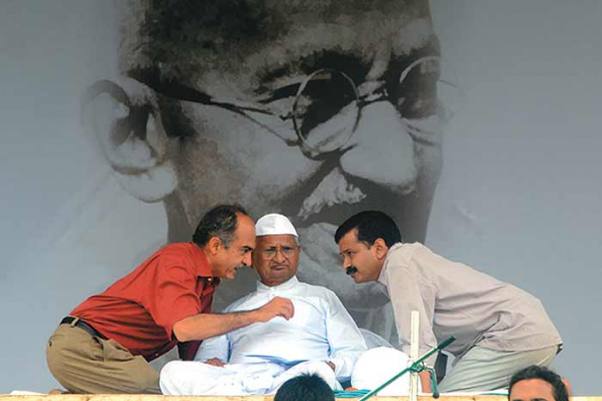
Prashant Bhushan along with Anna Hazare and Arvind Kejriwal at Ramlila Maidan during anti-corruption protests in 2011
Prashant Bhushan became an active member of this movement. In March 2012, he and a few other members of the crusade accompanied by the chief crusader, Anna Hazare, went to the PMO’s office for a meeting. Thereupon, Hazare formed a joint committee which would draft the final version of the Jan Lokpal Bill. Prashant Bhushan became one of the prominent members of Team Anna after Hazare included him in the drafting committee. Several meetings took place between the committee and government discussing the proposed bill. Prashant Bhushan was of the view that Lokpal should be an independent body which should have the authority to investigate and persecute all the public servants. In June 2011, the UPA government presented the draft of the Lokpal Bill, which excluded the key proposals made by Team Anna. On 4 August 2011, the government came up with its version of the Lokpal Bill in the Lok Sabha. Prashant Bhushan together with other members of IAC denounced the bill, stating it was weak and will safeguard the corrupt public servants. Anna Hazare held a hunger strike at Jantar Mantar in Delhi to pressurise the government to form and implement strict Lokpal laws.
After repeatedly failed negation talks with the government representatives, a part of Team Anna activists, including Prashant Bhushan, Arvind Kejriwal, Manish Sisodia, and Yogendra Yadav entered politics to pass the bill themselves.
Entry and Eviction from the Aam Aadmi Party (AAP)
Although Prashant Bhushan is the son of a former Law Minister of India, he was away from politics until 2012, after which he willingly decided to enter the politics. Prashant took this decision after the 2011 Anti-Corruption Protests failed to produce the desired results. He held that all the present political parties were corrupt, so there is a need to form a new political party. On 2 October 2012, he along with a section of members from Team Anna formed Aam Aadmi Party and appointed Arvind Kejriwal as its president.
Ahead of the 2015 Delhi Vidhan Sabha Elections, Prashant Bhushan accused Arvind Kejriwal to be diverting away from the core ideologies on which they formed the Aam Aadmi Party. He criticised him for arbitrarily selecting MLA candidates with a dubious reputation just to win the elections. He also submitted a list of 12 fielded candidates by the AAP with tainted history. After the elections, a national disciplinary committee of Aam Aadmi Party (AAP) expelled Prashant Bhushan together with Yogendra Yadav and two others from the AAP on 20 April 2015. The party’s national disciplinary committee ousted Prashant Bhushan, Yogendra Yadav, Anand Kumar, and Ajit Jha from the party. “They were expelled for gross indiscipline, anti-party activities and violation of the code of conduct of the party,” said party spokesperson Deepak Bajpai explaining the expulsion. Both Prashant Bhushan and Yogendra Yadav denied the allegations put on them for their ouster. Following the expulsion from the Aam Aadmi Party, Prashant Bhushan and Yogendra Yadav formed a new socio-political organisation called the Swaraj Abhiyan.
Association with Civil Society Organisations
Here are a few civil society organisations Prashant Bhushan is affiliated to or has been a part of the undermentioned organisations:
- The Campaign for Judicial Accountability and Reforms (CJAR)
- The National Campaign for People’s Right to Information (NCPRI)
- The National Alliance of People’s Movements (NAPM)
- Transparency International (India)
- The Centre for Public Interest Litigation (CPIL)
- Common Cause
- Swaraj Abhiyan
- India Against Corruption (IAC)
- The Committee on Judicial Accountability (CJA)
- The Campaign for Judicial Accountability and Judicial Reforms (CJAR)
Founder of Samabhaavanaa Institute
Located in the beautiful hills of Palampur, Sambhaavanaa Institute of Public Policy and Politics is an institute founded by Prashant Bhushan, which works towards educating youth about public policies and politics. It offers a variety of short courses, runs programmes, and organise seminars for students and civil society activists.
Controversies
- In 2009, Prashant Bhushan gave an interview to Tehelka TV, wherein he said, “In my view, out of the last 16 to 17 Chief Justices, half have been corrupt. I can’t prove this, though we had evidence against Punchhi, Anand, and Sabharwal on the basis of which we sought their impeachment.” In 2010, Harish Salve, a senior lawyer, lodged a contempt of court case against him for his statement. In response to that, the Supreme Court of India asked him to apologise for his remark. Subsequently, Bhushan explained why he felt that the former Chief Justices were corrupt. [1]The Outlook On 30 August 2022, the Supreme Court dropped contempt proceedings initiated against him for his remarks on judicial corruption in Tehelka magazine in 2009. According to a three-judge Bench led by Justice Indira Banerjee, the case should not proceed further after the explanation rendered by Prashant Bhushan about his intent and the circumstances which led him to make the comments. [2]The Hindu
- In 2011, during the days when he was a part of Team Anna, Prashant made a controversial statement during a press conference, wherein, he commented in favour of revoking Armed Forces Special Powers Act from the state of Jammu and Kashmir and supported the demand of referendum in Kashmir. He said, “It is my personal opinion that no country or part of its territory can be governed without the wishes of the people with the help of the army. This is not in the interest of the country and the people. I want that the situation is normalised, Army be withdrawn, the Armed Forces Special Powers Act be also withdrawn and then try to persuade the people of Kashmir to stay with India. And yet, if the people want, then there could be a plebiscite, and if the people of the Valley want separation, they are allowed to separate.” The controversy attracted heavy protests against Prashant Bhushan.
On 12 October 2011, a few members of Bhagat Singh Kranti Sena got into his chamber in the Supreme court and assaulted him for making which they saw as divisive, and accused him of trying to break India. However, Prashant Bhushan stood by his statement and quoted his attackers as the people having an authoritarian mindset.
- On 2 April 2017, criticising the anti-Romeo squads formed by the Yogi Adityanath government in Uttar Pradesh, Bhushan had tweeted, ‘Romeo loved just one lady, while Krishna was a legendary eve-teaser. Would Adityanath have the guts to call his vigilantes anti-Krishna squads?’ Bhushan’s tweet attracted wrath from religious conservatives and devotees of Hindu religion who considered the tweet as an attack on Hinduism. In response, Akhil Bharat Hindu Maha Sabha registered a lawsuit against Prashant Bhushan for hurting people’s emotions. However, he apologised for his remarks later and deleted the tweet. [3]The Hindustan Times
I realise that my tweet on Romeo squads&Krishna was inappropriately phrased&unintentionally hurt sentiments of many ppl. Apologize&delete it
— Prashant Bhushan (@pbhushan1) April 4, 2017
- On 9 July 2020, a petition was filed by Advocate Mahek Maheswari seeking to initiate contempt of court proceedings against Advocate Prashant Bhushan for his tweets.
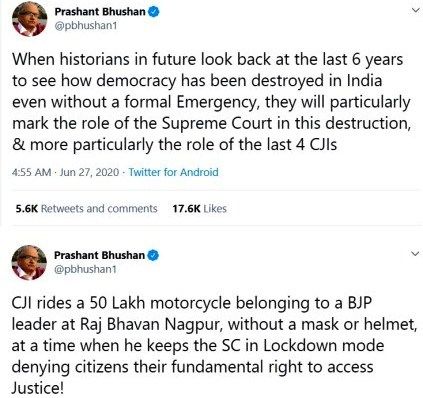
Based on the petition, on 21 July 2020, the Supreme Court of India took a suo motu cognizance and initiated a contempt of court proceedings against Bhushan. SC expressed its prima facie view by saying Bhushan’s Tweets brought disrepute to justice administration & undermined the dignity of CJI’s office. Justice Arun Mishra, head of the Supreme Court bench for the case, maintained that these tweets were not just personal opinions and that they intended to “shake the public confidence in the judiciary’s institution.” On 14 August 2020, the Supreme Court of India held Prashant Bhushan guilty of contempt of court for the two tweets he posted on his Twitter account. [4]Live Law On 31 August, the Supreme court of India pronounced the punishment in the case and imposed rupee one token fine on Prashant Bhushan. [5]Live Law On 14 September 2020, Prashant Bhushan paid the one rupee fine in the Supreme Court registry. While interacting with the media before entering the Supreme Court premises, he said, “Just because I’m submitting the fine does not mean I have accepted the verdict” He also filed a review plea in the apex court challenging his conviction in the case. [6]The Hindu
Publications
- “The Case That Shook India” (Vikas Publications, 1977): This was the first book written by Prashant Bhushan which deals with the case filed by Raj Narain to challenge the election of the former Indian Prime Minister, Mrs Indira Gandhi in the Lok Sabha Elections of 1971. Bhushan has described day-to-day proceedings in the case through all the stages until the judgement which eventually led to the declaration of emergency in 1975.
- “Bofors: The Selling Of A Nation” (Vision Books, 1990): The book unravels “Bofors Gun deal scam.”
Facts/Trivia
- Since the introduction of Public Interest Litigation in 1986, the advocate-activist, Prashant Bhushan, has filed more than 500 PIL’s for safeguarding public interest in different issues. [7]The Quint
- His opinion articles are often featured in many reputed newspapers.
- In India, judges are not legally bound to declare their assets. In 2009, Senior Prashant Bhushan wrote hundreds of letter to judges of different courts requesting them to voluntarily reveal their assets, responding to it, a few judges from various courts across India declared their assets. [8]The Wire
- He was president of the People’s Union for Civil Liberties (PUCL) for Delhi, one of the oldest Human Rights Organisation of India, founded in 1976. [9]The Times of India
- Based on his PIL, Supreme Court suspended the illegal mining operations in all the 90 mines in Goa in October 2012.
- Prashant Bhushan assisted the activists of Narmada Bachao Andolan opposing the construction of Sardar Sarovar Dam.
- During an interview given to The Times of India in 2011, Prashant Bhushan claimed that he spends around twenty-five percent of his time for the cases which remunerate him, while only charging minimal fees, just five percent of what his peers would charge.
- He advises fresh Lawyers to not choose the legal career to just make a fortune out of it, rather see it as a means for providing justice to people.

